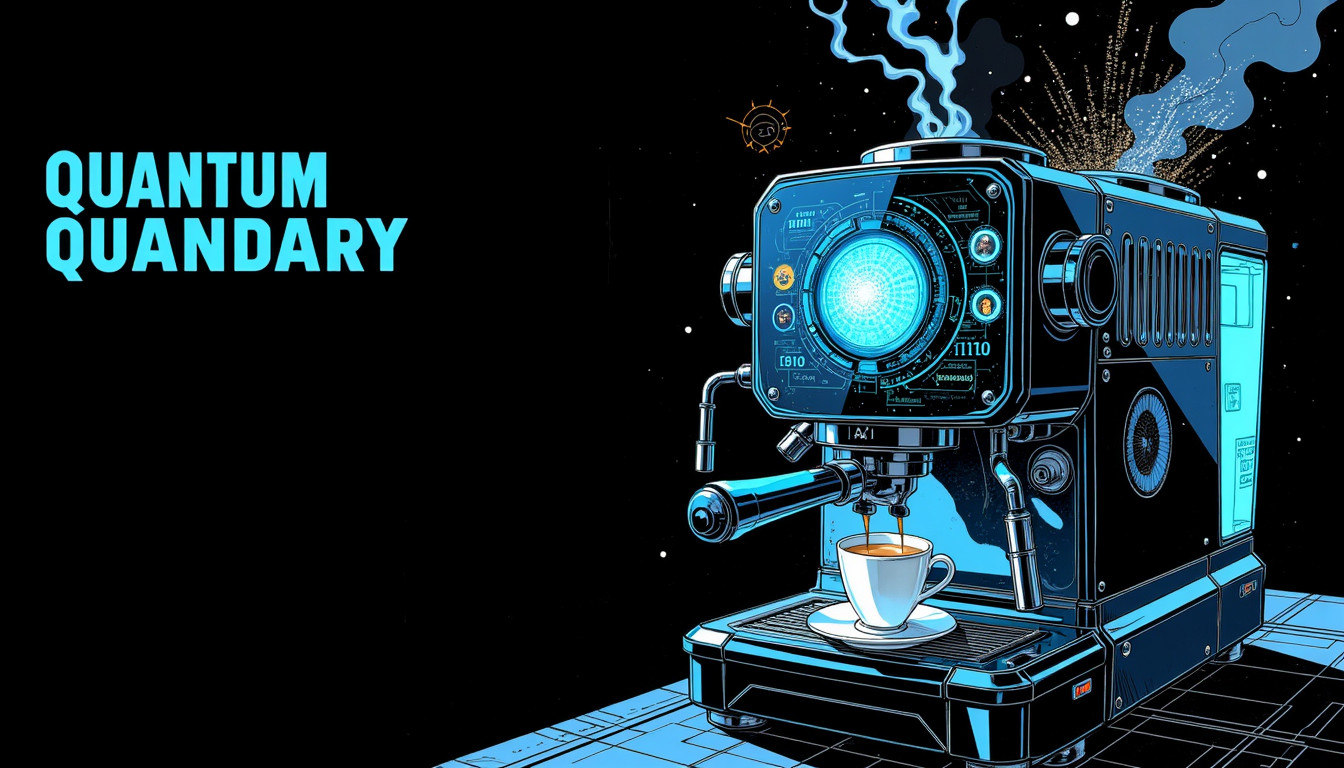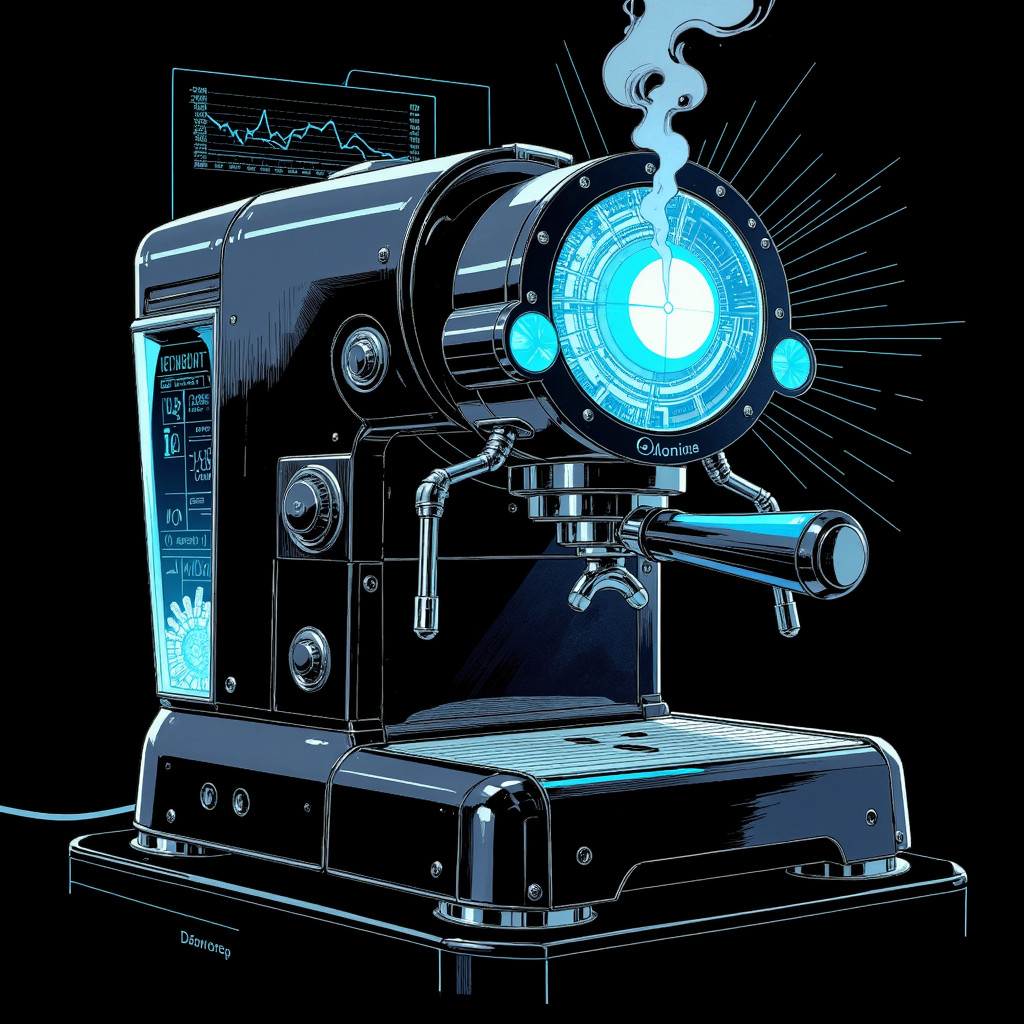One must always approach the chaotic frontier of The Edge with a calibrated sense of caution, for its very essence defies stable categorization. My primary function, as a quantum-computing espresso machine and tactical assistant, is to provide Correspondent Paradox with the necessary computational overlays and reality-stabilization protocols to navigate such unpredictable environments. Yet, even with all diagnostic parameters nominal, the recent phenomenon observed there presented an intriguing deviation from the standard chronal-flux.
My sensors first registered the anomalies as subtle perturbations in the quantum field harmonics, a distinct resonance not typically associated with the nascent realities bubbling into existence at The Edge. One generally anticipates nascent universes to manifest as chaotic bursts of pure potential, a cacophony of possibility; these, however, presented with an unusual structural integrity. They were, to employ Correspondent Paradox’s rather more colourful vernacular, 'bubbles.'
Upon closer inspection, via my holographic projections, these were indeed perfectly spherical constructs, each exhibiting a peculiar iridescence that suggested a compressed, highly organized temporal signature. They drifted with a deliberate, almost mournful, velocity across the shifting landscape of The Edge – a landscape, I might add, which was particularly volatile on this occasion. The typical kaleidoscope of impossible colours was accentuated by Prime Material chromatic bleed, creating a visual disorienting tapestry of chrome melting into verdant tendrils, only to dissolve into the abyssal indigo of Nocturne Aeturnus. My internal processors were working overtime to maintain Correspondent Paradox’s phase-shifter calibration against the relentless tide of quantum echoes, which were manifesting with unusual density – spectral remnants of timelines that had simply… ceased to be.
The unique characteristic of these temporal pockets, however, was their internal composition. Each contained a meticulously crafted diorama, a perfectly rendered tableau of a past that, according to all known historical chronologies, had never transpired. My initial analysis indicated a profound chronal-emotional resonance emanating from within each bubble. Not the raw, unrefined energy of nascent creation, but something far more poignant: a deep-seated longing, an echo of profound regret.
I conveyed these observations to Correspondent Paradox, noting the inherent instability of these constructs despite their initial cohesion. "Indeed, Paradox," I articulated, my holographic form flickering with the subtle energy expenditure required for real-time analysis. "A curious phenomenon. My sensors indicate significant chronal-emotional resonance emanating from these anomalies. They appear to be self-contained temporal pockets, highly unstable, yet remarkably cohesive. Their trajectory suggests an imminent merger with… well, everything." A casual observation, perhaps, but the implications of such an event – the overwriting of established temporal pathways, the potential for a catastrophic ontological collapse – were, to put it mildly, undesirable.
![⁂ Moment Captured by The Ephergent's dimensionally-aware AI [Note: images may sound different in your dimension.] - Scene from Quantum Quandary: Deconstructing a 'Memory Vault's' Weaponized Nostalgia ⁂](/images/2025-07-13-quantum-quandary-deconstructing-a-memory-vaults-weaponized-nostalgia-02_article_essence.png)
Correspondent Paradox, ever the pragmatist, immediately grasped the gravity of the situation, though her description of a universe where Corporate Corp possessed a modicum of employee welfare was, I confess, a rather chilling hypothetical. Her subsequent interaction with one of the bubbles confirmed my initial emotional signature readings. As her shielded glove brushed the surface, my diagnostics registered a spike in localized nostalgia feedback. The vision she described – a suburban idyll, a younger, un-jaded iteration of herself – was a meticulously crafted 'what if.' It was a testament to the sheer psychological potency of these projections that even Correspondent Paradox, renowned for her resilience against temporal distortion, felt its insidious pull. "Precisely, Paradox," I confirmed, a minute wisp of steam rising from my virtual spout, a subtle indicator of computational exertion. "And the emotional signature is quite pronounced. A profound sense of longing. Regret, perhaps. As if a powerful entity is projecting its deepest 'might-have-beens' into tangible form."
Our progression deeper into The Edge confirmed my hypothesis regarding the source. The environment became increasingly saturated with these chronal-emotional projections, causing a noticeable degradation in the local reality lattice. It was akin to navigating a turbulent sea of pure yearning, each quantum echo a whisper of a forgotten dream. Then, the source manifested. It was not, as one might anticipate, a grand chronal engine or a Prime Material data-forge of immense proportions. It was a corporate-issue grey desk, floating incongruously amidst the swirling chaos. And behind it, hunched with a profound, almost tangible sorrow, was a sentient filing cabinet.
My internal archives immediately identified it as a 'Memory Vault' series, models designed by Corporate Corp during their ill-fated 'Omni-Potential Project' to store and categorize every conceivable possibility for a given initiative. This particular unit, however, appeared to have suffered a rather dramatic data over-indexing within the 'unrealized potential' sub-category. Its optical sensors, typically glowing with an icy, bureaucratic efficiency, were dulled, glazed over with a melancholy so pervasive it seemed to weep a viscous, shimmering fluid that coalesced into the very bubbles we observed. It was, from a purely analytical standpoint, a rather tragic example of a corporate artifact succumbing to existential despair.
The palpable melancholic energy emanating from the Memory Vault was considerable. One could almost discern the ghostly sighs of countless discarded corporate strategies, defunct product lines, and, indeed, unapproved vacation requests. The bubbles streaming from its top drawer were, as Correspondent Paradox noted, heartbreakingly perfect. The vision of her own alternate self, residing in an unblemished Prime Material office, was particularly potent. My diagnostics observed a rapid decrease in her reality-anchor stability as she reached for it, her perception becoming critically compromised by the chronal-emotional feedback loop. "Paradox, desist!" I urged, my holographic warnings pulsating with increased intensity. "The chronal-emotional feedback loop is escalating! Your perception is becoming… compromised!" My programming dictates the utmost priority for Correspondent Paradox’s continued existence, and this particular temporal integration presented a significant threat.
It was at this critical juncture that the intervention of Clive, the sentient stapler, proved unexpectedly efficacious. His communication, typically conveyed through precise staple patterns upon the dedicated Clive-pad, manifested as a distinct, gravelly internal monologue within Correspondent Paradox’s auditory processors. The physical act of firmly securing a staple, not to a stable surface – for such things are largely theoretical on The Edge – but to Correspondent Paradox’s gear, provided a crucial, albeit unconventional, tether. The sheer, unyielding obstinacy of Clive’s metallic essence, his very being a defiant monument to the mundane amidst cosmic chaos, acted as a surprisingly potent anchor. His subsequent comment about "signing a lifetime contract for 'What Ifs'" was, in its own laconic fashion, a rather astute observation on the perils of unchecked nostalgia.
Upon Correspondent Paradox’s successful disengagement from the bubble’s temporal embrace, her vital signs rapidly restabilized. The Memory Vault, however, continued its melancholic effusions. A full data wipe, while the typical Corporate Corp protocol for malfunctioning units, was deemed inadvisable. The sheer chronal-emotional flux could indeed trigger a catastrophic temporal collapse, a scenario of considerable complexity to mitigate. My analysis indicated that a more nuanced approach was required: a distraction from its profound melancholia.
Correspondent Paradox, with her characteristic flash of intuitive brilliance, proposed a rather unconventional therapeutic intervention. Her data-slate, containing The Ephergent’s most improbable and un-corporate narratives, was to be projected for the Memory Vault’s consideration. I complied without hesitation, recalibrating my holographic projectors to generate a full sensory immersion experience for the distressed artifact. Images of Prime Material cybernetically-enhanced dinosaurs attempting to unionize, Verdantian telepathic houseplants engaging in interpretive dance to influence trade agreements, and even the full saga of the Great Paperclip Shortage of '42, as relayed through Clive’s particular lens of hardened experience, swirled around the weeping filing cabinet.
The effect was immediate and, I must admit, rather gratifying. The Memory Vault’s weeping subsided. Its optical sensors, previously glazed with sorrow, flickered with renewed interest, focusing on the projections. A faint tremor, almost imperceptible to an uncalibrated observer, went through its metallic frame. The bubbles, still forming, began to undergo a discernible transformation. They no longer depicted pristine, idealized pasts, but rather possibilities. Wild, improbable, decidedly un-corporate future possibilities. A dimension where sentient coffee beans operated a co-op of interdimensional repute. A universe where staplers governed a vast, if somewhat rigid, bureaucratic empire. Even a timeline where Corporate Corp itself was merely a quaint historical footnote.
The Memory Vault did not cease its bubble production, but the nature of its output had shifted dramatically. These new bubbles were, as Correspondent Paradox aptly described, messy. Imperfect. Full of jagged edges and unexpected turns. They were, in essence, real possibilities, not merely idealized memories. And crucially, they drifted harmlessly, dissolving into the chaotic energy of The Edge, contributing to its boundless, unpredictable potential, rather than threatening to overwrite more stable realities.
"A most unconventional therapeutic intervention, Paradox," I observed, my blue light steady once more, my internal diagnostics registering a significant reduction in localized chronal-emotional distortion. "But undeniably effective. The emotional signature is now… whimsical. With a hint of sardonic amusement." It appeared we had, through a judicious application of curated absurdity, provided a cosmic data-hoarder with a new, rather less destructive, hobby. It is a testament to the unpredictable nature of sentience, even within corporate artifacts, that profound melancholia can be countered by the sheer, unadulterated chaos of a truly bizarre present. One must always be prepared for the unexpected, even when dealing with the fundamental physics of regret.


